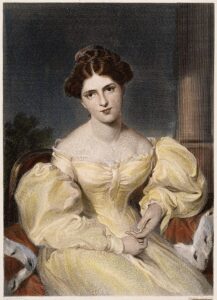
3346928 FRANCES ANNE ‘FANNY’ KEMBLE (1809-1893). English actress. Stipple engraving, 1873, after a painting by Sir Thomas Lawrence.; (add.info.: FRANCES ANNE ‘FANNY’ KEMBLE (1809-1893). English actress. Stipple engraving, 1873, after a painting by Sir Thomas Lawrence.); Granger.
“To Be Or Not To – HEY! That Should NOT Be!!!!”
Breadwinner, Actress, Wife, Mother, Poet, Author, Playwright, Divorcee, Family Savior, Abolitionist, Bloomer-Wearing Trendsetter….
Beautiful, talented British Fanny Kemble of the famous English theatrical family, was keen on acting but when her father was facing bankruptcy, she took to the Covent Garden stage playing Shakespeare’s Juliet and saved the family from financial ruin. A few years later, the family again fell on hard times and again she saved them when she toured America, where she thrilled the masses, became a famous beloved actress and met her future husband. Pierce Butler was smitten. A gentleman from a distinguished and wealthy Philadelphia family, his famous grandfather “Major Butler” was a Revolutionary War Veteran and an author of the Fugitive Slave Act.
They settled in Georgia and by the time their two daughters, Sarah and Frances were born, Mr. Butler was no longer so impressed with his wife’s artistry when instead of devoting all of her time to him, she spent some of her time writing, including a treatise on anti-slavery that HE FORBADE her to publish. Guess he thought one author in the family was enough. When he inherited an island full of slaves and The Butler Family went to stay (for four months) Fanny was appalled, aghast and against the inhumane treatment of the slaves. Her husband was not interested in her feelings or thoughts so like any great writer she wrote them down in her diary, which later was published. In the meantime, she fervently protested to her husband, but “me thinks the lady doth protest too much” and the marriage ended. Badly. Mr. Butler sued her for her divorce on the grounds of abandonment. Yes she abandoned a life married to slavery. But, as was the case in those days she lost custody of her children. Although she did gain more fame and respect and quite the honorable place in history as an abolitionist when her diary of life on an island with slaves, Journal of a Residence on a Georgian Plantation, was published, turning British sentiment against slavery during the Civil War. She is also known as the first gal to wear the pantaloons, the Turkish costume that became known as the controversial Bloomer Costume. Fanny Kemble spent the rest of her life writing and performing, choosing to be or not to be.